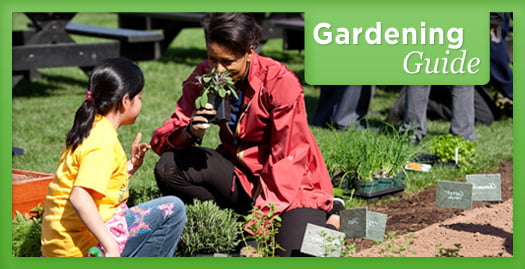Rethinking the School Garden
by Amanda Tirado, Administrative Assistant / Student at Boston Architectural College, and Greg Barrett, M.Ed, REFP / Educational Planner
Some may wonder why schools are good places for gardening, but evidence shows that gardens can actually be great places for schooling. In fact, the U.S. used to have many more school gardens, which helped lead students to many state universities that began as agricultural schools. This was a vestige from our European roots (a continent that has chosen to keep more school gardens over the years), but one we left behind mid-century to turn to a seemingly more efficient factory-like model of schooling. Education thought leaders have been revisiting school gardens for decades. Dr. Maria Montessori, one of the most influential voices in education, thought that gardens had a unique engaging power with kids:
“Children indeed love flowers, but they need to do something more than remain among them and contemplate their colored blossoms. They find their greatest pleasure in acting, in knowing, in exploring, even apart from the attraction of external beauty.”
She wasn’t alone in connecting natural experiences with education either. Harvard’s Dr. Howard Gardner challenged the idea of the singular IQ by describing the “multiple intelligences” that his work defined; one of these being the naturalist intelligence, which he sums up as “the ability to make consequential distinctions in the world of nature.”[1] Both of these educators must have been onto something, because the data shows real gains: as much as 15% increases in standardized tests scores were shown in a longitudinal study of schools that incorporated gardening into their curriculum. Teachers will be on board too, since current teaching seeks those real-life experiences to foster authentic learning.[2]
Educational gains are, of course, central to what educators do, but we mustn’t overlook the basic needs of children either. Health and safety have taken on a new role in the modern education world, and school gardens can help address these concerns. Over the past couple decades, the childhood obesity rate has tripled [3], and, since kids have around a third of their meal times in cafeterias, schools have a huge opportunity to show healthy eating habits. Putting it front and center on the national stage, then First Lady Michelle Obama championed school gardening as part of her Let’s Move campaign to end childhood obesity within a generation.[4] What’s more is that school gardens may be most impactful for America’s most needy districts, like those in urban food deserts; districts which also typically carry many more minority students who are nearly one and a half times more likely to be obese.[5]

To take care of our youth’s bodies and minds, more and more schools are petitioning districts, writing grants, getting volunteers together, and much more to bring the garden back onto school grounds. Gardens can be in a schoolyard or in raised beds, and don’t need much more than a couple of hundred square feet, which, given the possible benefits, doesn’t seem like so much. So, although schools may have left behind gardens in the past, it may again be time to revisit having gardens at schools today.
_________________________________________________________________
[1] Real Results. (2013). Retrieved from www.realschoolgardens.org/real-results.aspx
[2] Donovan, S., Bransford, J., & Pellegrino. (1999). How People Learn: Bridging Research and Practice. Washington, DC: National Academy of Sciences.
[3] Ogden CL, Carroll MD, Fryar CD, Flegal KM. Prevalence of obesity among adults and youth: United States, 2011–2014. NCHS data brief, no 219. Hyattsville, MD: National Center for Health Statistics. 2015.
[4] Let’s Move. (2010). Retrieved from http://www.letsmove.gov/gardening-guide
[5] Ogden CL, Carroll MD, Fryar CD, Flegal KM. Prevalence of obesity among adults and youth: United States, 2011–2014. NCHS data brief, no 219. Hyattsville, MD: National Center for Health Statistics. 2015.
